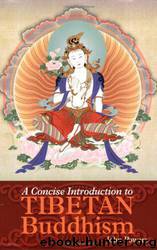A Concise Introduction to Tibetan Buddhism by John Powers

Author:John Powers
Language: eng
Format: azw3
Tags: Religion, Buddhism, Eastern, Tibetan, General
ISBN: 9781559392969
Publisher: Snow Lion
Published: 2008-04-28T00:00:00+00:00
Om Vajrasattva, protect the pledge. Vajrasattva, may I be supported by you. Remain firmly with me; be pleased with me; be happy with me. Be affectionate toward me. Bestow all attainments on me. Purify my karma. Make my mind virtuous. Hūṃ ha hahahahoḥ; all the blessed Tathagatas, may I be liberated in the vajra, O great pledge being of the nature of the vajra, aḥ hūṃ.
In ngöndro practice, one repeats this mantra one hundred thousand times. It is often recommended that one also repeat the short Vajrasattva mantra, oṃ vajrasattva hūṃ. This should be done as often as possible, ideally six hundred thousand times. The purpose of this is to focus the mind on Vajrasattva and contemplate his function of mental purification. Through this one becomes increasingly familiar with the concept of purification, and this in turn contributes to its actualization within the psycho-physical continuum.
The meditator then recalls all past faults and transgressions of religious vows. She confesses them to Vajrasattva, asks for his blessings, and resolves not to commit such offenses in the future. Vajrasattva then dissolves into the meditator, and she contemplates the fact that this image, like her own psycho-physical continuum, is empty of inherent existence. She realizes that her own faults and negativities are similarly empty, void of substantial existence, and so they may be purified through appropriate practices.
At the end of every session of practice one offers any benefits that derive from it for the benefit of all sentient beings. This is an essential element of closure, since it assures that one’s motivation is not a selfish one but that one is pursuing this practice due to altruistic intentions. In order to assure that one does not become attached to the form of the image, one then visualizes Vajrasattva being absorbed into light, and then he is absorbed into oneself. One thinks of one’s own body, speech, and mind as being transformed into those of Vajrasattva, and one realizes that one has internalized the awakened qualities of the deity.
Download
This site does not store any files on its server. We only index and link to content provided by other sites. Please contact the content providers to delete copyright contents if any and email us, we'll remove relevant links or contents immediately.
The Way of Zen by Alan W. Watts(6476)
Ego Is the Enemy by Ryan Holiday(5263)
The Art of Happiness by The Dalai Lama(4046)
The Book of Joy by Dalai Lama(3879)
Why Buddhism is True by Robert Wright(3387)
Spark Joy by Marie Kondo(3226)
Shift into Freedom by Loch Kelly(3121)
Happiness by Matthieu Ricard(2974)
A Monk's Guide to a Clean House and Mind by Shoukei Matsumoto(2854)
The Lost Art of Good Conversation by Sakyong Mipham(2545)
The Meaning of the Library by unknow(2485)
The Unfettered Mind: Writings from a Zen Master to a Master Swordsman by Takuan Soho(2234)
The Third Eye by T. Lobsang Rampa(2213)
Anthology by T J(2149)
Red Shambhala by Andrei Znamenski(2132)
The Diamond Cutter by Geshe Michael Roach(2005)
Thoughts Without A Thinker: Psychotherapy from a Buddhist Perspective by Epstein Mark(1949)
Twilight of Idols and Anti-Christ by Friedrich Nietzsche(1836)
Advice Not Given by Mark Epstein(1826)
